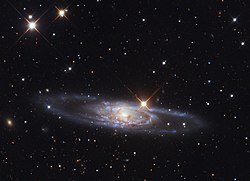NGC 5792
| Galaxie NGC 5792 | |
|---|---|
 | |
| Aufgenommen mit dem 81-cm-Spiegelteleskop des Mount-Lemmon-Observatoriums | |
| AladinLite | |
| Sternbild | Waage |
| Position Äquinoktium: J2000.0, Epoche: J2000.0 | |
| Rektaszension | 14h 58m 22,7s [1] |
| Deklination | −01° 05′ 28″ [1] |
| Erscheinungsbild | |
| Morphologischer Typ | SB(rs)b / HII[1] |
| Helligkeit (visuell) | 11,3 mag[2] |
| Helligkeit (B-Band) | 12,1 mag[2] |
| Winkelausdehnung | 6,8′ × 1,7′[2] |
| Positionswinkel | 84°[2] |
| Flächenhelligkeit | 13,8 mag/arcmin²[2] |
| Physikalische Daten | |
| Rotverschiebung | 0,006411 ± 0,000013[1] |
| Radialgeschwindigkeit | (1922 ± 4) km/s[1] |
| Hubbledistanz H0 = 73 km/(s • Mpc) | (86 ± 6) · 106 Lj (26,3 ± 1,8) Mpc [1] |
| Geschichte | |
| Entdeckung | William Herschel |
| Entdeckungsdatum | 11. April 1787 |
| Katalogbezeichnungen | |
| NGC 5792 • UGC 9631 • PGC 53499 • CGCG 020-038 • MCG +00-38-012 • IRAS 14557-0053 • 2MASX J14582270-0105278 • GC 4013 • H II 683 • HIPASS J1458-01 | |
NGC 5792 ist eine Balkenspiralgalaxie vom Hubble-Typ SBb im Sternbild Waage auf der Ekliptik. Sie ist schätzungsweise 86 Millionen Lichtjahre von der Milchstraße entfernt.
Entdeckt wurde das Objekt am 11. April 1787 von William Herschel.[3]
- Ultraviolett-Aufnahme von NGC 5792 mithilfe von GALEX
- Hochaufgelöste Aufnahme des Zentrums von NGC 5792, erstellt mithilfe des Hubble-Weltraumteleskops
Weblinks
Einzelnachweise
Auf dieser Seite verwendete Medien
NGC 5792 galaxy by GALEX
Autor/Urheber: Credit Line and Copyright Adam Block/Steward Observatory/University of Arizona, Lizenz: CC BY-SA 3.0 us
NGC 5792
Picture Details:
Optics Schulman 0.8m Telescope (RCOS) Camera SBIG STX 16803 Filters AstroDon Generation II Dates March 2018, April 2020 Location Mount Lemmon SkyCenter Exposure LRGB = 10 : 5 : 5 : 5 Hours Acquisition Astronomy Control Panel (DC3 Dreams), Maxim DL (Cyanogen), FlatMan XL (Alnitak) Processing PixInsight Credit Line and Copyright Adam Block/Mount Lemmon SkyCenter/University of Arizona.
Autor/Urheber: Sloan Digital Sky Survey, Lizenz: CC BY 4.0

Angle of view: 10' × 6' (0.3" per pixel), north is up.
Details on the image processing pipeline: https://www.sdss.org/dr14/imaging/jpg-images-on-skyserver/Autor/Urheber: Judy Schmidt from USA, Lizenz: CC BY 2.0
What's going on at the center of NGC 5792? A supermassive black hole, maybe. What's up with that dust? Is it really flared out like that, or is this a line of sight trick? And, if it is flared, what's causing it? I'm not really sure.
Data from the following proposal were used to create this image: Addressing a Bias in the Galaxies with Black Hole Mass Measurements
Red: WFC3/IR F160W (50% opacity) Orange: WFC3/UVIS F814W Blue: WFC3/UVIS F475W
North is 32.88° counter-clockwise from up.





